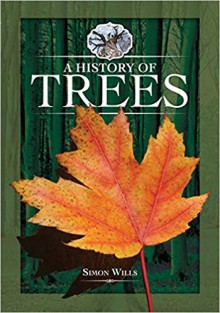
Thanks to Rosie and the whole team at Pen & Sword for providing me a hardback copy of this beautiful book that I freely chose to review.
I love trees and I can’t imagine living in a place with no trees at all, even if they are not in their natural environment, as is the case in cities. I’m not a connoisseur, although I’ve read some books that featured trees prominently and have enjoyed them, and this volume seemed the perfect opportunity to learn more.
This is a beautiful book that would make a perfect present for anybody interested in trees, in general, and UK trees in particular. It is a photographic book, but it also contains a wealth of written information about trees: factual and botanical data, historical events related to specific trees, folk and mythological stories about them, literary connections, etc. As the author explains in the introduction, due to the limits in the length of the book he could not include all British trees, and he selected the ones he felt were not only better known but had also the best tales to tell. Not that I had any doubt about it, but the author makes a good case for his choice of topic in the introduction: “Beyond their practical utility to us and our simple liking of them, trees form the great forests of the world, which are said to be the lungs of the planet. So trees, more than anything else, keep us alive” (Wills, 2018, p. vi).
The list of trees included in the book are: alder, apple, ash, bay, beech, birch, cherry, elm, hawthorn, hazel, holly, hornbeam, horse chestnut, lime, London plane, magnolia, maple, monkey puzzle, oak, pear, pine, poplar, rowan, sweet chestnut, sycamore, walnut, willow and yew.
This is a book one can deep in and out of as one fancies, or read it cover to cover. I often found myself picking it up just to have a quick look, and discovered an hour later that I was still glued to its pages and its wonderful stories. The original photographs are beautiful, and there are also well-chosen images from the British Library and the Welcome collection, as the author explains in his acknowledgements. The writing is supple and I’d dare say it will appeal to a large variety of people, because although it is not perhaps addressed at botanists or experts, it shares plenty of anecdotes and stories likely to interest most readers.
I had to share this ditty, because we’re in spring already and, well, one never knows:
The fair maid who, the first of May,
Goes to the fields at break of day,
And washes in dew from the hawthorn tree,
Will ever after handsome be (Wills, 2018, p. 67).
If you try it and it works, don’t forget to let me know!
I enjoyed the pictures, the stories, and I became convinced as I read the book that I’d like to read more of the author’s works, and I’d love to attend one of his lectures. Of course, he had me at the acknowledgements already, when he mentioned his dog, Max (oh, don’t worry; there’s a picture of him too).
“Finally, I would like to thank Max, to whom this book is dedicated, for allowing me to frequently stop his walk and take photos of trees. He’s very tolerant” (Mills, 2018, p. viii).
In sum, this is a beautiful, informative, entertaining, and amusing book that will delight all those who love nature, trees in particular, and who enjoy trivia, stories and photographs. Perfect as a present, for yourself or others, as an inspiration, and as a breath of fresh air. Enjoy!
Wills, S. (2018). A history of trees. Barnsley, UK: Pen & Sword White Owl.

 Log in with Facebook
Log in with Facebook 















